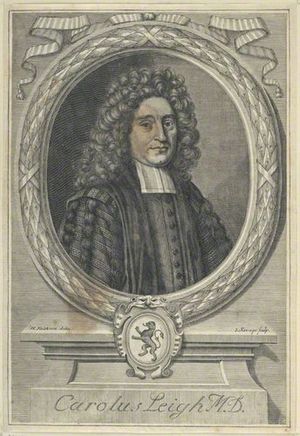Charles Leigh (physician) facts for kids
Quick facts for kids
Charles Leigh
|
|
|---|---|

Charles Leigh, 1700 engraving by John Savage.
|
|
| Born | 1662 Singleton Grange
|
| Died | 1701? |
| Nationality | British |
| Occupation | Naturalist |
| Known for | Fellow of the Royal Society |
Charles Leigh (born 1662, died around 1701) was an English doctor and a naturalist. A naturalist is someone who studies nature, including plants, animals, and the natural world. He was known for his work in medicine and for exploring the natural history of parts of England.
Contents
Charles Leigh's Early Life and Education
Charles Leigh was born in 1662 at Singleton Grange in Lancashire, England. His father was William Leigh.
When he was about 17 years old, in 1679, Charles went to Brasenose College, Oxford, a famous university. He earned his first degree there in 1683. Later, he continued his studies at Jesus College, Cambridge. At Cambridge, he earned two more degrees, including one in medicine (M.D.) in 1689. This meant he was qualified to be a doctor.
Becoming a Scientist
In 1685, Charles Leigh was chosen to be a Fellow of the Royal Society. This is a very old and respected group of scientists in the United Kingdom. Being a Fellow means you are recognized for your important contributions to science.
After finishing his studies, Leigh worked as a doctor. He first practiced medicine in London. Later, he moved to Manchester and became a well-known doctor in the Lancashire area. He helped many people with their health.
His Important Books and Studies
Charles Leigh wrote several books about his studies and observations. These books helped people learn more about medicine and the natural world.
Studies on Health and Minerals
- Phthisologia Lancastriensis (1694): This book was about health issues in Lancashire. It also included his thoughts on the minerals and natural springs found in the area. It was even reprinted in Geneva in 1736.
- Exercitationes quinque (1697): This book was a collection of five studies. It covered topics like mineral waters, hot springs, sudden illnesses, fevers that came and went, and a condition called dropsy (which causes swelling).
Exploring Nature and History
- The Natural History of Lancashire, Cheshire, and the Peak in Derbyshire (1700): This was his most famous work. In this book, he described the plants, animals, and geology of these regions. He also wrote about ancient objects and history found there, from British, Phoenician, Armenian, Greek, and Roman times. This book had a special picture of him at the front.
Leigh also wrote some shorter articles. These included responses to other doctors about topics like the "Heat of the Blood" and how to treat a viper's bite. His "Natural History" book was mostly a translation of his earlier Latin writings into English.
His Family Life
Charles Leigh married a woman named Dorothy Shuttleworth. She came from Larbrick in Lancashire. Through his marriage, he received part of the Larbrick estate. However, this land was later given up to pay off a debt he owed. Charles Leigh did not have any children. His wife, Dorothy, passed away before 1717.
Charles Leigh is believed to have died around 1701, though the exact date is not fully known.

